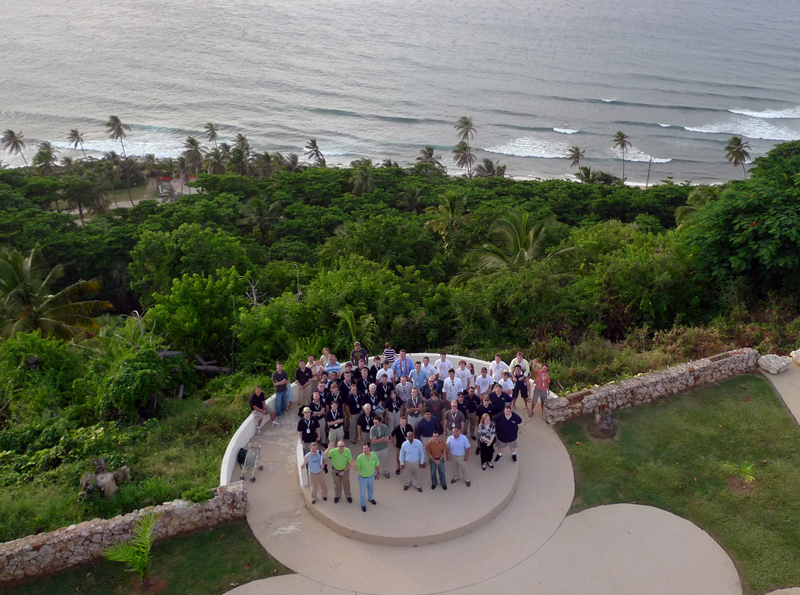
International Aerial Robotics Competition
During the 4th Mission, teams had already demonstrated all of the required aerial robotic behaviors mandated in the IARC Rules, except being able to demonstrate all of these behaviors seamlessly in under 15 minutes... however that was considered by the Organizer and Judges to be inevitable and no longer a significant challenge.
The new 5th Mission picked up where the 4th Mission left off. The 5th Mission required a fully autonomous aerial subvehicle - launched from a "mother ship" - to penetrate a building and negotiate the more complex interior space containing hallways, small rooms, obstacles, and dead ends in order to search for a designated target without the aid of global-positioning navigational aids, and relay pictures back to a monitoring station some distance from the building.
The 5th Mission continued to adhere to the Competition's 18-year practice of posing tasks that cannot be completed with current technology and skills. As with previous missions, nothing within the World military or industrial arsenal of robots is able to complete the proposed mission at the time the guidelines are released.
In an outstanding performance, a team of nine students from the Massachusetts Institute of Technology (MIT) won the 5th Mission of the AUVSI International Aerial Robotics Competition (IARC) which was held on the campus of the University of Puerto Rico at Mayagüez (UPRM).
Of the ten teams officially registered in the Competition, a field of seven attended the 19th annual event. Of those seven, three teams were finalists that competed in the UPRM coliseum on the 22nd of July, 2009. Going head-to-head was the Georgia Institute of Technology, Embry-Riddle Aeronautical University, and the Massachusetts Institute of Technology. Each team had a different approach to solving the challenge posed by the 5th Mission, not only in terms of aerial robot configuration, but also the strategy for sensing and navigation apart from GPS cues.
The Embry-Riddle team developed a unique "monocopter" which had a single rotor blade and an opposing ducted fan (see figure). Although the team did not win the Competition, it did win an award for the "Most Innovative Air Vehicle". Georgia Tech approached the mission with a coaxial rotor helicopter that used a wall-following algorithm to search for the target within the hallways and rooms of the arena. MIT used a four-propeller "quad rotor" design that had a laser scanner to create a map of its surroundings as well as an optical system to aid in relative motion of the air vehicle.
In the end, this proved to be the most robust solution, allowing the MIT aerial robot to navigate hallways and rooms while avoiding obstacles. Even so, MIT was unable to find the target (a particular nuclear power plant control panel gauge) until minutes before its final fourth attempt timed out. The MIT aerial robot was able to be launched under JAUS control, report its position while creating a map of its surroundings and progress (see figure), and ultimately encountered the target which it successfully identified and photographed, sending pictures back to the Judges.
For their stellar performance, the MIT team was awarded the $10,000 IARC prize, and for completing the entire mission during the first year of the 5th Mission will, according to the Official Rules, receive its $1,000 entry fee back as part of the incentive program to encourage teams to put forth their best performance during the first year of the mission. In fact, this is the first time in the past 19 years of the IARC that any team has ever won during the first year of the mission. In 1995 Stanford University completed the 1st Mission on their first appearance at the IARC, but that was four years into the mission. In 1997 a team from Carnegie Mellon University completed the 2nd Mission on their first appearance at the IARC, but again, this was not achieved until the second year of the mission.
.png)
.png)
.png)
.png)

.png)

 Embry-Riddle Aeronautical University: Daytona Beach, Florida, United States
Embry-Riddle Aeronautical University: Daytona Beach, Florida, United States Georgia Institute of Technology: Atlanta, Georgia, United States
Georgia Institute of Technology: Atlanta, Georgia, United States Indian Institute of Technology - Madras: Chennai, Tamilnadu, India
Indian Institute of Technology - Madras: Chennai, Tamilnadu, India Massachusetts Institute of Technology: Cambridge, Massachusetts, United States
Massachusetts Institute of Technology: Cambridge, Massachusetts, United States Oregon State University: Corvallis, Oregon, United States
Oregon State University: Corvallis, Oregon, United States Pima Community College: Tucson, Arizona, United States
Pima Community College: Tucson, Arizona, United States South Dakota School of Mines and Technology: Rapid City, South Dakota, United States
South Dakota School of Mines and Technology: Rapid City, South Dakota, United States University of Puerto Rico: Mayagüez, Puerto Rico
University of Puerto Rico: Mayagüez, Puerto Rico Vel Tech Technical University: Chennai, Tamilnadu, India
Vel Tech Technical University: Chennai, Tamilnadu, India Virginia Polytechnic Institute: Blacksburg, Virginia, United States
Virginia Polytechnic Institute: Blacksburg, Virginia, United States